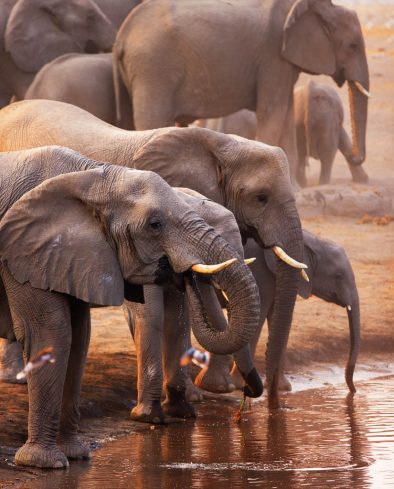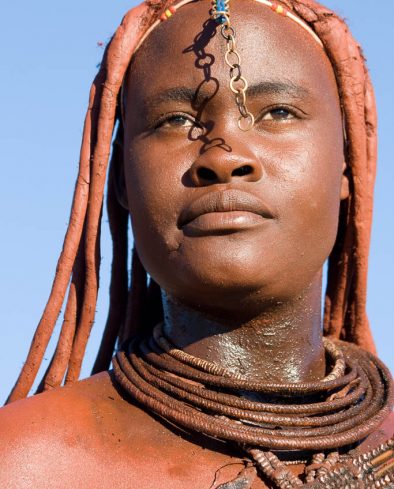Episode 23 - Namibia
Few world countries can rival Namibia for natural splendor. From the world's second largest canyon to its highest sand dunes and Africa's largest national park, Namibia is all about monumental scale, space, and surreal landscapes.
Listen Now
The World’s Biggest Sand Dune Desert
Welcome to Namibia. Relax, close your eyes. Because once inside, there is nothing. From every angle, the desert is the same. Piles of sand connected by sweeping curves and steeplings, unclimbable walls. With each step, nothing is achieved. The foot sinks in, the leg pulls out, the body moves on, and yet all there is, is sand.
Another indistinguishable angle, then a break, a drifting eagle contemplating its chances, searching for a lizard in the sand below. In Namibia, it’s easy to think that there is nothing but sand. The whole entire western half of Namibia is the world’s biggest sand dune desert. The whole of Namibia as a country is a desert.
And as you close your eyes and imagine, you can imagine that everything will be the same and as you travel to the sand dunes, you can see it all after ten minutes. But that is to underestimate how beautiful the sand dunes can be. Because in Namibia nothing is ever the same. The sand dunes are ephemeral. They are constantly changing. They are neverending. Once within them, you can feel the primitive majesty. As you are surrounded by a 360 degree landscape — a landscape untouched by human hand for so many millions of years.
No Two Views Are Ever The Same
And there’s this desert paradox. From every angle it is the same, but no two views are ever the same. Every peak, every ridge, every curve, every canyon, has its distinctive sizes, its matchless shape. Throughout the day, the dunes change colour. Beneath the scorching midday sun they are yellow bleached, without detail. As the sun starts to set through the afternoon, they go into an orange, then ocre, then a red and then black — then shadow.
You can see the shapes beneath the moon, but not their colours. And then, as the sun rises the next morning, that colour palette repeats itself, every minute a subtly different hue. Every minute, the wind, you can see the winds making changes to the dunes. So, no walk in the desert is ever the same. Maybe your footprints will remain for days, but maybe your footprints will be swept away before nightfall. The evidence of your appearance disappearing as the sand keeps coming and coming,
Land in Namibia and spend the day, and you can think, “I think I’ve seen it all”. But after ten days in Namibia, I understood that I could never see it all. I couldn’t even see a little bit of it. And after returning to Namibia three different times, I still want to go back because there is always so much more. And that is Namibia’s overwhelming power. In Namibia, I felt like I was forever on a journey that nobody could ever replicate. A journey in a landscape of fascinatingly delicate nuances, a place where I knew I was seeing a different angle to the next person.
Namibia is like nature’s art gallery. There are so few people, you can go for days without seeing people. And it’s not just the sands. There are great rock formations, a great area called Damaraland crossed by desert-adapted elephants, among other wildlife. There are great salt flats, salt flats that change with the seasons where lions and leopards lay in wait for zebra and antelope who come to drink. In Namibia — deep inside Namibia — you will find Fish River Canyon.
Now I bet you know the name of the world’s biggest canyon, the Grand Canyon in the United States, but nobody knows the second biggest is Fish River Canyon in Southern Namibia. The world’s second biggest canyon. It receives fewer visitors per year than the Grand Canyon receives in a single day.
Where Nature Will Always Rule
Namibia was colonized, but very belatedly because they turned up — the Portuguese, the Dutch, the English — they turned up, they saw the sand, and their shipwrecks ended up in the sand. There’s a beautiful stretch of coast known as the Skeleton Coast, littered with shipwrecks from vessels covering 300, 400 years, that have been washed ashore and then slowly, inexorably, taken over by the sand dunes.
There is a wonderful town called Lüderitz that is currently being taken over by the sand. It’s a town for — kind of got some wealth, because it’s in the middle of nowhere, but they found diamonds. And the sand just keeps coming and coming, so now Lüderitz is half abandoned. Just up the road, there’s a town called Kolmanskop and it’s been abandoned for 30 years because the sand dunes took over. You can walk into a house and find a bathtub poking out of the sand. You can still find like the first floor just peering above the sand dunes.
Nature is so incredibly powerful in Namibia and it’s on such a scale, it makes you feel so incredibly humbled. It makes you feel serene. So just traveling these enormous landscapes, where there are no other people, there is no way you can change this landscape, all you can do is feel the beauty, the power of the journey.
And that is what a trip to Namibia is all about. A trip to Namibia is not going for three days to see some sand dunes. Even if you can do these beautiful trips by airplane flying over, seeing the sand dunes, seeing the coast, seeing safari — a trip to Namibia can only be understood if you go for at least ten days, if you make a long experience of it and you connect these epic landscapes where people will only ever be visitors, and nature will always, always rule.






